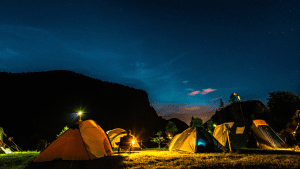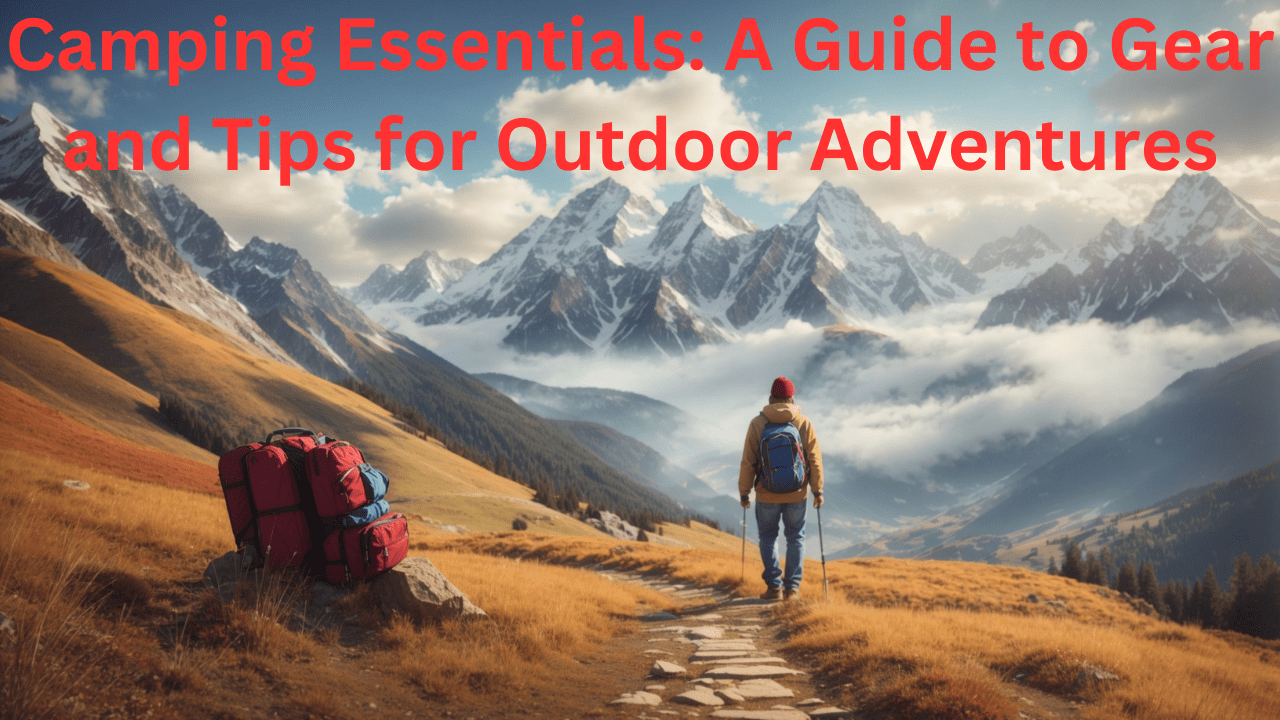Camping Essentials: A Guide to Gear and Tips for Outdoor Adventures
Camping is more than just a recreational activity; it’s a chance to connect with nature, unplug from the daily grind, and experience the great outdoors. To ensure a successful and enjoyable camping trip, having the right essentials is crucial. In this comprehensive guide, we’ll delve into the must-have gear and essential tips for a memorable camping experience.
I. Introduction
A. Definition of Camping Essentials
When we talk about camping essentials, we refer to the gear and equipment that are fundamental for a safe and comfortable outdoor experience. These items vary depending on factors such as location, season, and personal preferences.
B. Importance of Having the Right Gear
The right gear can make or break a camping trip. From shelter to navigation tools, each item plays a vital role in ensuring you’re well-prepared for whatever nature throws your way. (Camping Essentials)
II. Shelter and Sleeping Gear
Camping Essentials: For Shelter and Sleeping Gear
A. Choosing the Right Tent
Selecting the appropriate tent involves considering factors like size, weight, and weather resistance. A durable, weather-appropriate tent is your first line of defense against the elements.
B. Sleeping Bags and Pads for Comfort
Investing in a quality sleeping bag and pad enhances your sleep quality in the wilderness. Ensure they’re suitable for the expected temperature range of your camping destination.
C. Importance of a Quality Sleeping System
A good night’s sleep is crucial for an enjoyable camping experience. A well-thought-out sleeping system includes not only the right bag and pad but also the choice of a comfortable campsite. (Camping Essentials)
III. Cooking and Food Supplies
A. Portable Stoves and Cooking Equipment
Compact and efficient cooking gear simplifies meal preparation. Portable stoves, lightweight cookware, and versatile utensils are essential for a well-rounded camping kitchen.
B. Essential Food Items for Camping
Strategically packing non-perishable, energy-dense foods ensures you have sufficient nourishment. Consider dietary restrictions and preferences when planning meals.
C. Tips for Meal Planning in the Wilderness
Plan your meals ahead, considering simplicity and nutritional value. Opt for easy-to-cook recipes that require minimal equipment and cleanup.
IV. Clothing and Footwear
A. Layering for Varying Weather Conditions
Dress in layers to adapt to temperature fluctuations. A base layer for moisture-wicking, an insulating layer for warmth, and a waterproof outer layer for protection are essential.
B. Choosing the Right Footwear for Different Terrains
The right footwear depends on your activities and terrain. Hiking boots for rugged trails, sandals for water crossings, and camp shoes for relaxing at the site are all important considerations.
C. Importance of Waterproof and Breathable Clothing
Unpredictable weather is part of the camping experience. Invest in waterproof and breathable clothing to stay dry and comfortable in changing conditions. (Camping Essentials)
V. Navigation and Communication
A. Maps, Compass, and GPS Devices
Navigational tools are crucial for staying on course. Bring detailed maps, a reliable compass, and a GPS device to ensure you can find your way in unfamiliar territory.
B. Importance of Communication Devices
In remote areas, a communication device can be a lifeline. Whether it’s a two-way radio, satellite phone, or emergency beacon, having a means to call for help is essential.
C. Safety Measures for Staying on Course
Share your itinerary with someone trustworthy. In case of an emergency, they’ll know where you are and when to expect your return. (Camping Essentials)
VI. First Aid and Emergency Preparedness
A. Basic First Aid Kit Essentials
A well-stocked first aid kit is a non-negotiable camping essential. Include bandages, antiseptic wipes, pain relievers, and any personal medications.
B. Emergency Protocols for Camping Trips
Familiarize yourself with basic first aid procedures and emergency protocols. Knowing what to do in critical situations can make all the difference.
C. Importance of Informing Someone About Your Plans
Before heading out, inform a friend or family member about your camping plans. Share details such as your destination, expected return date, and emergency contacts. (Camping Essentials)
VII. Campsite Essentials
A. Setting Up a Comfortable Campsite
Take the time to set up a comfortable and organized campsite. Clear the area of debris, set up a reliable tent, and create dedicated spaces for cooking and relaxation.
B. Importance of Proper Waste Disposal
Follow the leave-no-trace principles by properly disposing of waste. Pack out all trash, bury human waste in cat holes, and minimize your impact on the environment.
C. Leave-No-Trace Principles
Leave-no-trace principles are essential for preserving the natural beauty of camping spots. Minimize your impact by practicing responsible camping habits. (Camping Essentials)
VIII. Entertainment and Relaxation
A. Bringing Along Recreational Activities
While the focus is on nature, bringing along books, games, or musical instruments can enhance your camping experience during downtime.
B. Unplugging and Enjoying Nature
Take the opportunity to disconnect from technology and immerse yourself in the natural surroundings. Embrace the tranquility and beauty of the outdoors.
C. Balancing Adventure and Relaxation
Strike a balance between adventure and relaxation. Plan activities that excite you, but also allow time for leisure and reflection. (Camping Essentials)

IX. Wildlife Safety
A. Understanding Local Wildlife
Research the wildlife in the area and understand their behaviors. Knowing what to expect can help you avoid unwanted encounters.
B. Proper Food Storage to Avoid Attracting Animals
Store food securely to prevent attracting wildlife to your campsite. Use bear canisters or hang food in designated areas to minimize the risk of animal encounters.
C. What to Do in Case of Wildlife Encounters
Know how to react in case you encounter wildlife. Stay calm, make noise, and slowly back away. Understanding the appropriate response can prevent dangerous situations. (Camping Essentials)
X. Budget-Friendly Camping Gear
A. Finding Affordable and Quality Gear
Camping gear doesn’t have to break the bank. Look for budget-friendly options without compromising on quality. Consider second-hand gear or rental options.
B. Tips for Budget-Conscious Campers
Prioritize essential items and borrow or rent specialized gear for occasional trips. Join online communities for gear swaps and sales to find affordable options.
C. DIY Camping Equipment Ideas
Get creative with do-it-yourself camping gear. From homemade stoves to improvised cooking equipment, there are plenty of ways to save money without sacrificing functionality.
XI. Sustainable Camping Practices
A. Choosing Eco-Friendly Gear
Opt for gear made from sustainable materials. Consider the environmental impact of your choices and support brands committed to eco-friendly practices.
B. Minimizing Environmental Impact
Follow the principles of “leave no trace” camping. Minimize your impact by staying on designated trails, avoiding unnecessary disturbance to wildlife, and properly disposing of waste.
C. Participating in Conservation Efforts
Get involved in conservation initiatives. Join local clean-up events, contribute to reforestation projects, and support organizations working to preserve natural spaces. (Camping Essentials)
Camping Essentials: A Guide to New Gear and Tips for Outdoor Adventures No.1
XII. Tips for Camping with Pets
A. Preparing for a Pet-Friendly Camping Trip
If bringing pets, ensure they’re comfortable with outdoor activities. Pack essentials like pet food, water bowls, and any necessary medications.
B. Ensuring Pet Safety in the Outdoors
Keep pets on a leash and supervise them at all times. Be mindful of wildlife encounters and have a plan for handling pet-related emergencies.
C. Responsible Pet Ownership While Camping
Respect the environment and other campers by adhering to pet-friendly rules. Properly dispose of pet waste and minimize disturbance to wildlife.
XIII. Choosing the Right Campsite
A. Researching and Selecting a Suitable Location
Thoroughly research potential campsites. Consider factors like terrain, accessibility, and regulations. Choose a location that aligns with your preferences and camping style.
B. Checking Campsite Regulations and Permits
Ensure you’re aware of any permits or regulations for your chosen campsite. Some locations require advance reservations, while others may have specific rules for campfires or wildlife protection.
C. Evaluating the Terrain and Surroundings
Inspect the terrain and surroundings before setting up camp. Look for level ground, adequate shade, and proximity to water sources. Consider the impact of weather changes on your chosen location.
XIV. Weather Preparedness
A. Monitoring Weather Forecasts
Stay updated on weather forecasts leading up to and during your camping trip. Be prepared for sudden changes and adjust your plans accordingly.
B. Adjusting Plans Based on Weather Conditions
Flexibility is key when camping. If adverse weather is forecasted, be ready to modify your itinerary or even postpone your trip for safety reasons.
C. Importance of Staying Informed About Changes
Keep an eye on weather updates and be aware of any sudden changes in conditions. Staying informed allows you to make timely decisions for your safety and the safety of your group.
XV. Conclusion
A. Recap of Essential Camping Gear
In conclusion, the key to a successful camping trip lies in thorough preparation and having the right gear. From shelter and cooking essentials to safety measures and sustainable practices, each aspect contributes to a memorable outdoor experience.
B. Encouragement for Outdoor Adventures
Embark on your next camping adventure with confidence. Embrace the challenges and joys of outdoor living, and savor the beauty of nature.
C. Emphasizing the Importance of Preparation
Remember, preparation is the foundation of a successful camping trip. By considering every aspect of your journey, you’ll be better equipped to enjoy the wonders of the great outdoors.(Camping Essentials)
Frequently Asked Questions (FAQs)
1. Q: Can I go camping with minimal gear? A: While minimalism is possible, certain essentials like shelter, sleeping gear, and navigation tools are crucial for a safe and comfortable experience.
2. Q: How do I choose the right campsite? A: Research potential campsites, considering factors like terrain, regulations, and accessibility. Choose a location that aligns with your preferences and follows leave-no-trace principles.
3. Q: What should I do in case of a wildlife encounter? A: Stay calm, make noise, and slowly back away. Avoid direct eye contact and never approach or feed wild animals.
4. Q: How can I make my camping trip more eco-friendly? A: Choose eco-friendly gear, follow leave-no-trace principles, minimize disturbance to wildlife, and participate in conservation efforts.
5. Q: Is it necessary to inform someone about my camping plans? A: Yes, always inform a friend or family member about your plans. Share details such as your destination, expected return date, and emergency contacts.
You May Also Like:
Explore Your Travel Insurance Options Before Your Next Trip: A Comprehensive Guide
Transform Your Life with These 5 Healthy Lifestyle Tips
Find Your Portfolio’s Best Investment Options: A Step by Step Guide to Increasing Your Profits



